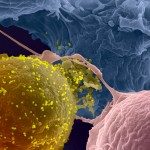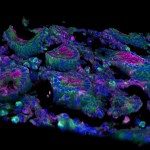Link to Pubmed [PMID] – 14694112
J Virol 2004 Jan; 78(2): 798-810
African green monkeys (AGMs) infected by simian immunodeficiency virus (SIV) SIVagm are resistant to AIDS. SIVagm-infected AGMs exhibit levels of viremia similar to those described during pathogenic human immunodeficiency virus type 1 (HIV-1) and SIVmac infections in humans and macaques, respectively, but contain lower viral loads in their lymph nodes. We addressed the potential role of dendritic cell-specific intercellular adhesion molecule 3-grabbing nonintegrin (DC-SIGN; CD209) in viral dissemination. In previous studies, it has been shown that human DC-SIGN and macaque DC-SIGN allow transmission of HIV and SIVmac to T cells. Here, we looked at the ability of DC-SIGN derived from AGM lymph nodes to interact with SIVagm. We show that DC-SIGN-expressing cells are present mainly in the medulla and often within the cortex and/or paracortex of AGM lymph nodes. We describe the isolation and characterization of at least three isoforms of dc-sign mRNA in lymph nodes of AGMs. The predicted amino acid sequence from the predominant mRNA isoform, DC-SIGNagm1, is 92 and 99% identical to the corresponding human and rhesus macaque DC-SIGN amino acid sequences, respectively. DC-SIGNagm1 is characterized by the lack of the fourth motif in the repeat domain. This deletion was also detected in the dc-sign gene derived from thirteen animals belonging to five other African monkey species and from four macaques (Macaca fascicularis and M. mulatta). Despite three- to seven-amino-acid modifications compared to DC-SIGNmac, DC-SIGNagm1 allows transmission of SIVagm to T cells. Furthermore, AGM monocyte-derived dendritic cells (MDDC) expressed at least 100,000 DC-SIGN molecules and were able to transmit SIVagm to T cells. At a low multiplicity of infection (10(-5) 50% tissue culture infective doses/cell), viral transmission by AGM MDDC was mainly DC-SIGN dependent. The present study reveals that DC-SIGN from a natural host species of SIV has the ability to act as an efficient attachment and transmission factor for SIVagm and suggests the absence of a direct link between this ability and viral load levels in lymph nodes.




